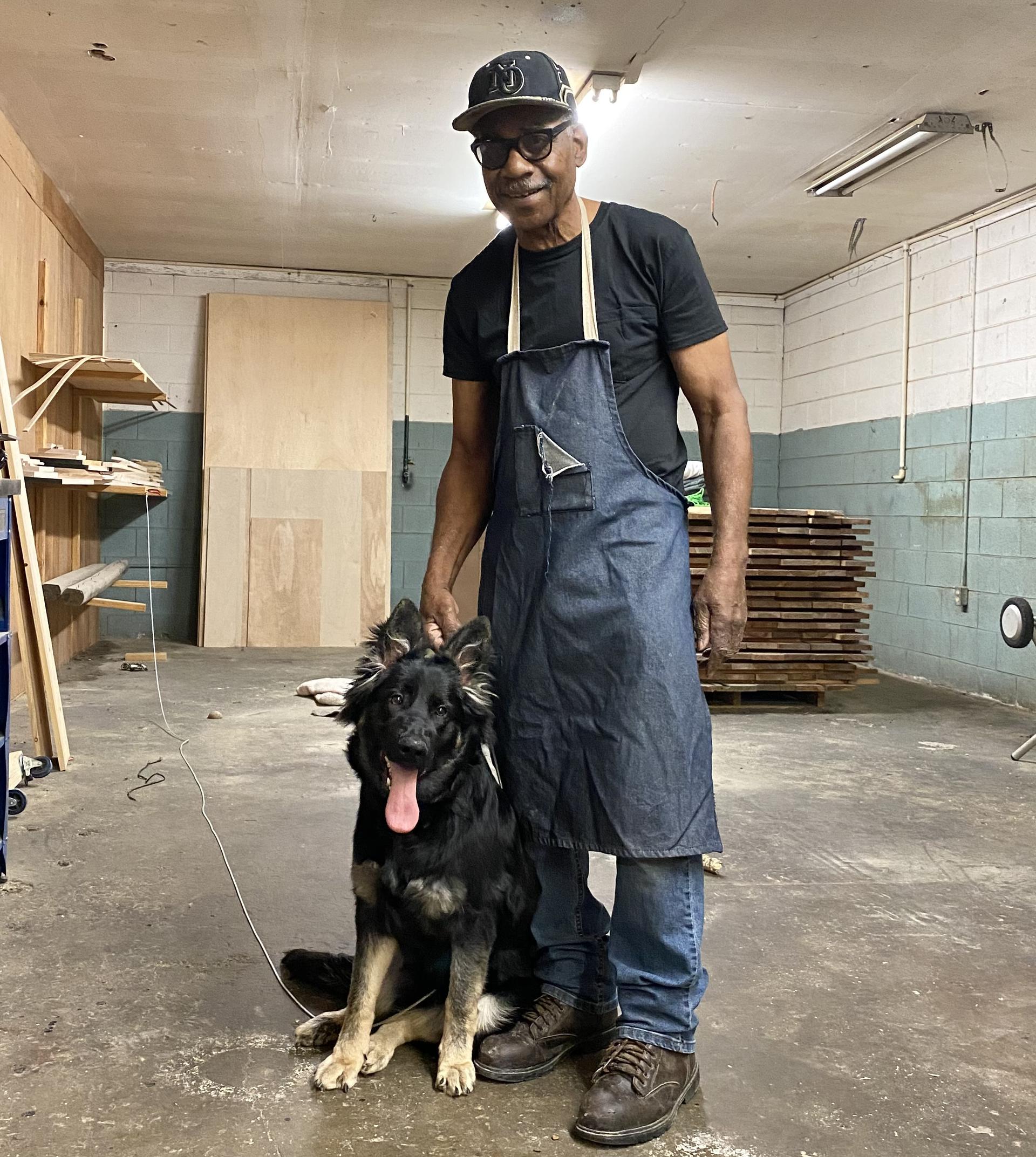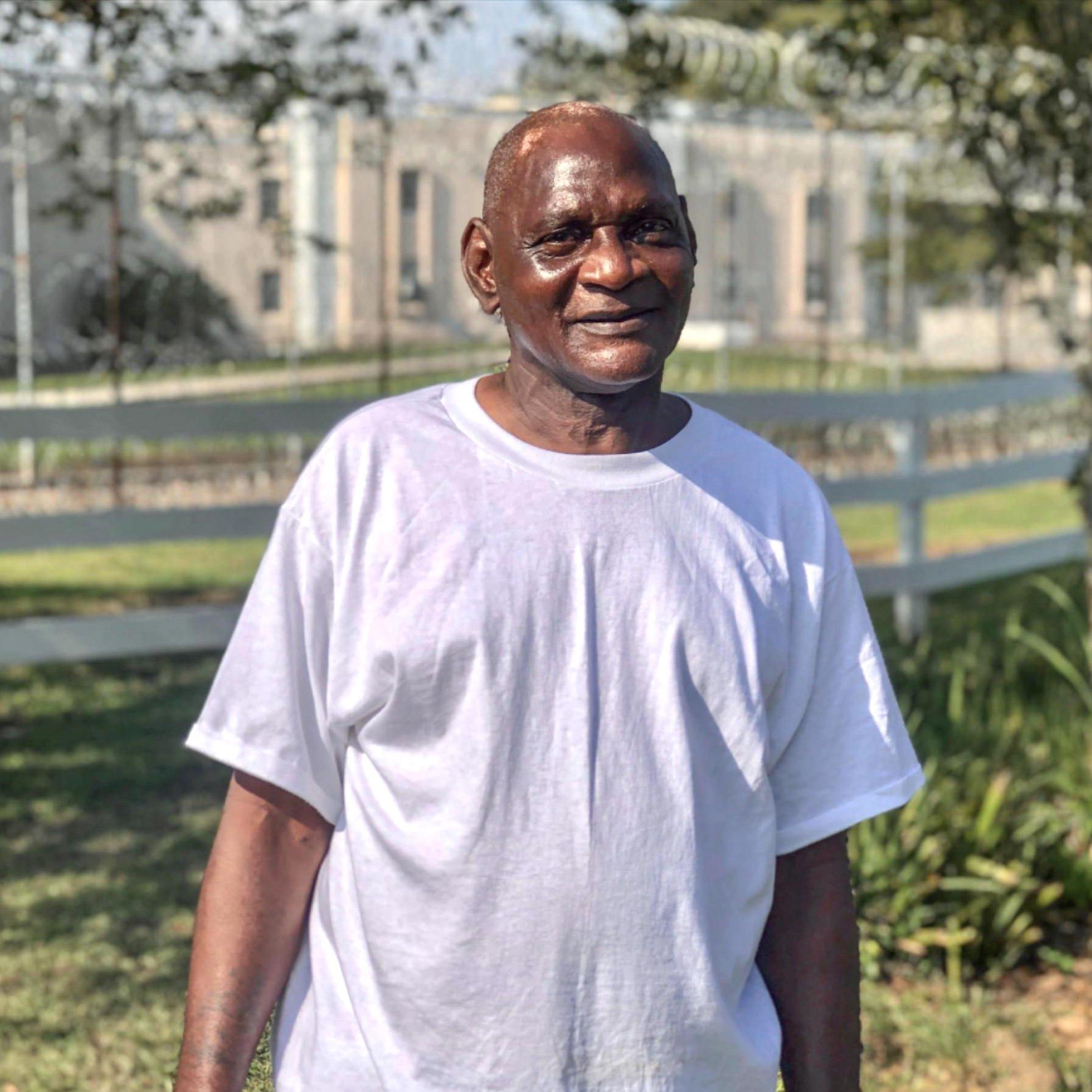Justice Reinvestment: LSU Helps Louisiana Decrease Mass Incarceration, Increase Workforce with Low-Risk Prisoners, Save >$150 Million Annually
April 05, 2021
Through faculty collaboration, student effort, and by using big data analysis to evaluate the risk prisoners pose to society and the needs they would have upon release—merging expertise in sociology and law—LSU has helped lower the Louisiana prison population by almost one-fourth in three years, saving the state more than $150 million annually.

Andrew Hundley spent 19 years in prison, sentenced to life without parole at 15 for second-degree murder, before being released on parole in part through LSU faculty efforts. He went on to earn a bachelor’s degree in sociology with a concentration in criminology at LSU. Today, he’s the executive director of Louisiana Parole Project, an advocacy, support, and peer mentorship organization staffed by former lifers such as himself to help newly released prisoners connect with resources and jobs. The recidivism rate among Louisiana Parole Project clients is 2%.
Since 2018, the Louisiana Department of Corrections uses TIGER, an LSU-developed tool, to help evaluate the risk posed by every incarcerated person in each of the eight prisons and numerous local jails across the state. All Louisiana prisoners now have a TIGER risk score, which guides critical decisions, such as who should (or shouldn’t) be released on parole. The tool also evaluates prisoners’ needs (such as mental health, past substance abuse, ability to get stuff done), which helps parole officers be almost surgical in how they invest their time and resources.
“When I first started working for the Louisiana Department of Corrections, we had nothing to help us do triage and objectively evaluate individual prisoners,” Assistant Secretary Rhett Covington, who spent 15 years as a parole officer, said. “Nothing but our experience and the biases that came along with that. We were flying by the seat of our pants with the limited resources we had, and there was no way to do true case management; each parolee got the kitchen sink.”
“The TIGER score now helps our field officers determine, ‘Who do I want to spend my time with, and who do I spot-check periodically,’” Covington continued. “We’re able to prioritize our resources and reinvest state funds where we get the biggest bang for our buck.”
The TIGER toolset was developed by LSU sociology professor Ed Shihadeh and attorney Keith Nordyke, who also is LSU Law adjunct faculty. Seeing how Louisiana was the incarceration capital of not just the nation, but the world—while having one of the highest crime rates—it became clear to Shihadeh and Nordyke that Louisiana could invest its money more wisely. Together with students, they helped turn a $1.75 million federal research grant into more than $150 million in annual savings for the state, in the context of Louisiana’s commitment to criminal justice reform. And those savings pertain to decreased costs of mass incarceration alone; not having to spend an average of $17,742 per prisoner per year for the 9,000 people who are not incarcerated today compared to in 2017, the year before TIGER was implemented. Between 2017 and today, the Louisiana prison population has shrunk by almost one-fourth, from more than 35,000 to less than 27,000. And there are other gains for the state as well—former prisoners become workers and taxpayers, contributing to state revenue, along with less crime and fewer victims. The overall recidivism rate (the number of parolees who return to prison within five years) has gone down from 47% to 42%—and likely lower still, since TIGER hasn’t been used for the full five-year period for which the state has the most recent data.
“The TIGER score now helps our field officers determine, ‘Who do I want to spend my time with, and who do I spot-check periodically.’ We’re able to prioritize our resources and reinvest state funds where we get the biggest bang for our buck.
Assistant Secretary Rhett Covington, Louisiana Department of Corrections
Before TIGER, the state used a rudimentary tool called LARNA (Louisiana Risk Needs Assessment) to help the parole board make decisions about which prisoners to release. It was based on 13 questions and had an accuracy rate of 62%.
“That’s about a coin flip,” Shihadeh said. “That’s not actionable data. You can’t tell me every person has about a 50/50 chance of committing another crime—I can’t work with that. Especially when the stakes are this high... So, the result of that system was that almost no one got out, including the people who pose little-to-no risk to society.”
During his research presentation at a January 2021 LSU Science Café event, Shihadeh showed a graph comparison between LARNA and TIGER. While the outcome of LARNA creates an almost perfect Bell curve (which Shihadeh calls “the maybe curve”) with the vast majority of prisoners being evaluated as medium-risk, TIGER results in something that looks more like a ski slope, with most prisoners on the low-risk side of the spectrum. The accuracy rate of TIGER is at least 80%—not perfect, but based on a much wider set of parameters and 15 years’ worth of data on what actually happened to more than 100,000 people released from prison in Louisiana; real outcomes. The tool is also continuously validated and further fine-tuned, including by a former student of Shihadeh’s who now works with the Louisiana Department of Corrections and as a research associate in the LSU Social Research and Evaluation Center, Tim Reling.
“We’re currently working on developing a series of more gender-responsive risk and needs algorithms,” Reling said. “These will be able to help predict recidivism for drug, property, and violent offenses specifically among men and women, which are not the same. Each algorithm is subjected to ten-fold cross-validated logistic regression procedures to ensure the internal validity and overall stability of the models.”

Theortric “Bojack” Givens with his dog, Termite, inside his recently opened custom cabinet and furniture business, Givens Woodwork, LLC in Port Allen, Louisiana. In part because of his TIGER score (low-risk, low-needs), Givens was released from Angola Prison after 44 years and received financial literacy training through Louisiana Parole Project. He believes in “quality, not quantity” when it comes to his craft. Recent commissions include a table and chair set, built-in cabinets and shelving units, and a custom storage unit for a large vinyl record collection. LSU Parole Assistance and Re-entry Clinic efforts were key to Givens’ release—so far this semester, the Clinic has enabled six clients to be released on parole, while two were denied.
– Photo courtesy of Louisiana Parole Project
In 2014, Nordyke also partnered with Robert Lancaster, assistant dean of experiential education at LSU Law, to create the LSU Parole Assistance and Re-entry Clinic, where students now use the TIGER score as a means of advocacy for prisoners (often juvenile and first-time offenders) who might deserve a second chance. One such person is Andrew Hundley, who was sentenced to life without parole for second-degree murder at the age of 15 in 1997. Originally from Eunice, Louisiana, Hundley was the first juvenile lifer to be released on parole in 2016, after 19 years in prison, finishing as a trustee on the Angola Prison cattle crew. This happened through the direct advocacy efforts of Nordyke combined with a promising (low-risk, low-needs) TIGER score, which was calculated specifically for Hundley’s parole hearing before being implemented statewide. During his incarceration, Hundley had first gotten his GED and then took LSU correspondence courses in political science and history, “just courses I enjoyed taking,” as well as classes offered through Louisiana Technical College.
“Those educational opportunities kept me going,” Hundley said. “They gave me hope and something to work toward; a way to better myself.”
After his release, Hundley enrolled at LSU as a fulltime student, graduating in record time just two years later with a bachelor’s degree in sociology with a concentration in criminology. Today, he’s the executive director of Louisiana Parole Project, an advocacy, support, and peer mentorship organization staffed entirely by former lifers who offer housing and various support services for recent parolees who might have exited society when Back to the Future was the number-one movie at the box office, around 1985—before computers and email addresses and cell phones, and usually before they ever had the chance to set foot in a restaurant, or learn how to drive.
“I try to be careful about how I use the tagline, ‘from tax burdens to tax payers,’ but our organization has seen bipartisan support based on economics alone ... One thing we’ve all been able to agree on is; let’s put these people to work.”
Andrew Hundley, former juvenile lifer, recent LSU graduate, and executive director of Louisiana Parole Project
“I try to be careful about how I use the tagline, ‘from tax burdens to tax payers,’ but our organization has seen bipartisan support based on economics alone,” Hundley said. “Even conservative business people, who wouldn’t necessarily be crazy about our type of program, have bought into it because keeping people who are no risk to society in jail shouldn’t be a drain on state resources—especially if we’ve been training them in prison to be able to come home and utilize new vocational skills, whether that’s carpentry or horticulture or small engine repair. One thing we’ve all been able to agree on is; let’s put these people to work.”
Louisiana Parole Project started with one rental apartment and now owns several houses in the Baton Rouge area. And they’ve been successful in getting former prisoners back to work and onto the straight and narrow. While the average Louisiana recidivism rate now is in the high 30s or low 40s, the recidivism rate among Louisiana Parole Project clients is less than 2%. About 85% are gainfully employed (some are too old or have serious health issues)—one started his own carpentry business (Lancaster recently invested in a custom vinyl record storage cabinet made of pure maple) while another took a job as a sign language interpreter having learned the skill at Louisiana State Penitentiary at Angola to help a hearing-impaired fellow prisoner.
Louisiana Parole Project, in turn, receives help from LSU students. Law students assist in representing clients at parole hearings, while LSU Sociology and Ogden Honors College students do full internships.
“And not just as paper-pushers and to help answer the phone,” Hundley said. “These students are part of the entire process; they come with us to do client interviews in prison, help us bring people home. That’s important to us because we recognize that these students will become business owners and decision makers, prosecutors and judges. No matter where they’ll be in life, I want them to know about this hidden part of our justice system—what happens later, after people come home. Everything else is front-page news; the crime, the court case, and the jail time. Not what happens after.”
Lucy Butterbaugh from New Orleans is a current intern who will graduate from LSU this spring with a bachelor’s degree in sociology. She plans on attending law school this fall.
“Before Louisiana Parole Project, I’d never thought of the ways in which I could help after incarceration instead of before; this inspired me to think bigger than I previously had, and I found that really comforting in a way.”
Lucy Butterbaugh, LSU senior in sociology and current Louisiana Prison Project intern with plans on attending law school this fall
“Through this internship, I’ve learned to see people as more than their criminal records,” she said. “Before Louisiana Parole Project, I’d never thought of the ways in which I could help after incarceration instead of before; this inspired me to think bigger than I previously had, and I found that really comforting in a way.”
Another LSU intern is Josh Hermanstorfer, a Louisiana Service and Leadership (LASAL) scholar at the Ogden Honors College.

Drake Brignac is a Roger Hadfield Ogden Honors College and LSU Manship School of Mass Communication student majoring in political communication, LSU Stamps Scholar, and president of the student-driven Tiger Prison Project.
“Louisiana Parole Project strives to make the transition from incarceration to society easier for formerly incarcerated men and women who have been in prison for 20, 30, sometimes more than 40 years,” he said. “It’s an extremely humbling experience, and without the help of Louisiana Parole Project, many of them would meet an overwhelming, fast-paced world without support to get them through. Our goal is to help these men and women become contributing members of society once again. It is difficult to find a more noble cause, and I feel like I’m actually contributing day-in and day-out. The simple interactions I get to have in the office each day continually reveal to me that we cannot be defined by the worst thing we have ever done—that will stick with me for a long time.”
Another LSU group Hundley collaborates with is the Tiger Prison Project, a student organization whose members volunteer to help Louisiana Parole Project clients learn how to use computers, smartphones, email, social media, WiFi, Google, and other technologies unfamiliar to them.
“As students who grew up alongside technology, volunteering is a humbling, gradual endeavor because it requires us to describe every step of activities that are almost second-nature,” Tiger Prison Project President Drake Brignac said. “But it’s one of the most enriching experiences and you’ll be hard-pressed to meet more grateful, patient people. We help teach them skills, but it’s equally important that Parole Project clients see that their community cares about them and wants them to succeed.”
Tiger Prison Project recently organized a month-long book drive to collect over 1,000 books for Louisiana prisoners, something the students could do safely despite the COVID-19 pandemic.
“To me, Tiger Prison Project builds optimism for the future of Louisiana, and helps bolster a sense of public service.”
Drake Brignac, president of Tiger Prison Project and LSU Stamps Scholar
“Most Louisianans may not know that 60% of adults in prison are functionally illiterate, while others frequently lack the resources to learn, entertain themselves, or meet benchmarks like earning a GED,” Brignac said. “To me, Tiger Prison Project builds optimism for the future of Louisiana, and helps bolster a sense of public service.”
A former Louisiana Parole Project intern and LSU sociology alumna, Jolie Duarte, now works as a victim services advocate for the Louisiana Victim Outreach Program under the Department of Corrections’ Board of Pardons and Committee on Parole. Before an offender’s parole hearing, Duarte contacts the victims involved to let them know what is going on and what they can do prior to and during the hearing.
“It is hard to even try to find reason to support an offender when all you hear about is the crime committed, which often is the case for victims. It’s seeing the changes offenders make in themselves while incarcerated that makes you want to support them, and especially if they only committed one crime and went to prison as teenagers.”
Jolie Duarte, victim services advocate for the Louisiana Victim Outreach Program, LSU sociology alumna, and former Louisiana Parole Project intern
“That internship set my career in motion,” she said. “I’d learned about TIGER from Dr. Shihadeh in class at LSU, and after seeing it in action, I began to understand just how useful it is in helping to determine whether an offender is granted parole or denied.”
“Now, as a victim services advocate, I don’t let my personal feelings or opinions get mixed in with the support we provide,” Duarte continued. “But due to my background with Louisiana Parole Project, I have a dual view on offenders being released, although each case is different. It is hard to even try to find reason to support an offender when all you hear about is the crime committed, which often is the case for victims. It’s seeing the changes offenders make in themselves while incarcerated that makes you want to support them, and especially if they only committed one crime and went to prison as teenagers.”

Fair Wayne Bryant stands outside the gates of Angola Prison where he was incarcerated for almost 24 years after being sentenced to life in prison for trying to steal a pair of hedge clippers from a carport. Louisiana Parole Project Executive Director Andrew Hundley and LSU Professor Robert Lancaster, director of the LSU Law Center Parole and Reentry Clinic, spoke on Bryant’s behalf at his parole hearing last fall. He now drives a forklift for a mulch company.
– Photo courtesy of Louisiana Parole Project
In two landmark cases, the U.S. Supreme Court made it possible for juvenile lifers to be released on parole. In 2012, Miller v. Alabama established that life without parole as a mandatory, one-size-fits-all sentence could not be applied to juveniles. And in 2016, Montgomery v. Louisiana said the previous ruling could apply retroactively. This is what set Hundley on the fast track toward parole—he was out in five months.
“I was lucky to have Keith [Nordyke] and parents who fought for me,” Hundley said. “And in prison, too—I developed relationships with people; friends in prison become family, and I knew many people who were no less deserving of a second chance than I was; people who could change, and do something. So, when I got home, I wanted to use the life experiences I’d had in prison and help others.”
“When I got out, there were no resources for people who’d just left prison—beyond maybe their own families and a few charities,” Hundley continued. “That’s how the idea for the Parole Project came about, as a way to help with reentry. We use TIGER, too, to determine who’d be a good client and who we might be able to help the most. If someone is high-risk, they’re less likely to be a good fit for a peer mentorship program like ours because what we do is entirely based on individuals having respect for us; we don’t have badges, and we don’t carry weapons. We’re not law enforcement officers—in fact, everyone who works with us are formerly incarcerated people—our mentorship model works because we’ve been in their shoes, and we understand what it takes to be successful.”
“We use TIGER, too, to determine who’d be a good client and who we might be able to help the most. If someone is high-risk, they’re less likely to be a good fit for a peer mentorship program like ours because what we do is entirely based on individuals having respect for us; we don’t have badges, and we don’t carry weapons.”
Andrew Hundley
Assistant Secretary Covington acknowledges the critical role an organization like Hundley’s can play.
“The Parole Project has done a phenomenal job in helping people navigate this new world,” he said. “You can have a low-risk person with high needs, and if those needs aren’t addressed, they will become high-risk because they’ll start getting desperate.”
“TIGER, as a state-of-the-art tool, helps all of us get the leg up,” Covington continued. “Instead of the kitchen sink response, ‘Do these 50 things to comply with parole,’ TIGER helps our field officers avoid putting too much time and effort into low-risk people, which actually increases their risk because a large amount of supervision takes them away from jobs and social situations. If you over-program low-risk people, it will mess them up and they’ll end up back in jail.”
Perhaps the biggest surprise for Nordyke and Shihadeh when they were looking at the data on 15 years’ worth of past releases was the recidivism rate among second-degree murderers, such as Hundley.
“It was zero,” Nordyke said. “Zero! That was big news, that you could get no recidivism out of these so-called ‘old, hardened criminals.’ Not a single one of them came back to prison. And among first-degree murderers, I don’t think we had more than two, and one of them went back to prison because of drunk driving. So, the issue at that point became, if you’ve got a choice between a drug user, a drunk driver, and a second-degree murderer for a neighbor, who should you pick, for your own family’s safety? You pick the murderer. It’s true.”
Shihadeh appreciates the power of big data to get to these types of surprising truths and discover solutions and possible savings for the state.
“We’ve demonstrated in Louisiana that we can do this smarter and safer.”
Ed Shihadeh, LSU professor of sociology and co-creator of the TIGER toolset to help evaluate the risk (and needs) posed by every prisoner in Louisiana
“We don’t have to spend enormous amounts of money on a bloated government program that doesn’t work,” he said. “We’ve demonstrated in Louisiana that we can do this smarter and safer.”
Jim Patterson, vice president of government relations at LABI (Louisiana Association of Business and Industry), appreciates what TIGER is doing for the Louisiana business community as well. Through various forums and other efforts, LABI has been helping to connect employers with what Patterson calls “returning citizens.”
“It’s all about helping businesses find the workers they need,” he said. “And what they need are workers who show up on time, do a good day’s work, and no drama. That’s why assessment techniques such as TIGER are so important. They help us increase the number of businesses out there willing to give these people—many of them hard workers with valuable skills—a chance.”
A Long Time Coming—LSU Alumna Shines New Light on Incarceration and 20-Year-Old LSU Social Work Case
Manship Professional-in-Residence Christopher Drew also involves LSU students in reporting on criminal justice through its Statehouse Bureau, news service, and other avenues. Criminal justice articles written by LSU Manship students: